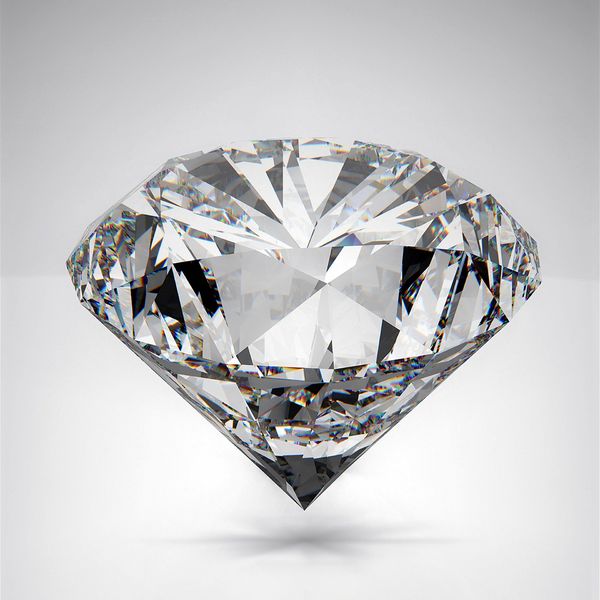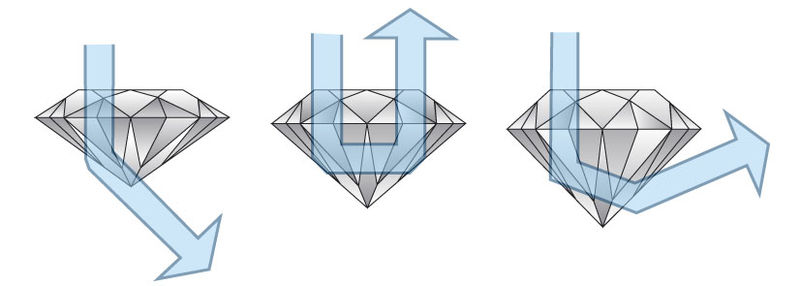Diamonds
A Buyer's Guide
 There is nothing quite like a diamond. It is found in the most remote places on Earth, and the fact that it forms at all is something of a miracle. It takes about one ton of rock to recover less than half a carat of rough, making diamonds one of the rarest and most desired gemstones in the world. A diamond is a testament of endurance and strength—and not surprisingly the ultimate symbol of love.
There is nothing quite like a diamond. It is found in the most remote places on Earth, and the fact that it forms at all is something of a miracle. It takes about one ton of rock to recover less than half a carat of rough, making diamonds one of the rarest and most desired gemstones in the world. A diamond is a testament of endurance and strength—and not surprisingly the ultimate symbol of love.
Every diamond is a miracle of time and place and chance. Like snowflakes, no two are exactly alike. Each reflects the story of its arduous journey from deep inside the Earth to a cherished object of adornment. Yet all diamonds share certain features that allow us to compare and evaluate them. These are the 4 C’s.
Carat - The Weight
The size of a diamond arguably has the biggest impact on price. The weight of pearls and gemstones is expressed in Carats (ct), which is a unit of mass equal to 0.2g (5ct = 1g). If all other factors are equal, the more the stone weighs, the more valuable it will be.
Colour - The Tone
A truly pure diamond should appear as a clear, colourless crystal. Colour in a diamond is caused by chemical anomalies and structural defects, the most common of which is yellowing caused by the presence of nitrogen.

A boron impurity will cause a blue diamond and irradiation can cause a green colour. Diamonds can also appear pink to purple, red, and even black.
Here, we will be looking at pure diamonds (also known as white diamonds) which, although many people think of gem quality diamonds as colourless, truly colourless diamonds are very rare.
The GIA scale of colour is shown below:

The difference in colour between D, E, and F coloured stones can only be seen by a gemmologist while comparing stones side by side in a controlled (and very white) environment, and an untrained eye would be unable to distinguish between stones up to grade H!
Clarity - The Purity
Being pure crystalized carbon that is formed deep within the Earth, super heated under vast amounts of pressure, it’s no surprise that most diamonds have ‘imperfections’ in them. These internal inclusions and surface blemishes are a part of a diamond’s story and a diamond without any such marks is incredibly rare, and just as valuable!
The clarity scale is a measure of the severity of those imperfections.

Cut - The Geometry
 The cut of a diamond is the only property which is totally dependant on man. A diamond cut is a style or design guide used when shaping a diamond for polishing such as the 'brilliant' cut. Cut refers not only to shape (pear, oval, etc.) but its symmetry, proportioning and the finish of a diamond. These factors are what determine the sparkle of the diamond. The goal in terms of extracting the greatest beauty from a diamond is to have light enter and then disperse as it bounces inside the gem, thereby producing the spectrum of colours and ‘sparkly’ effect, and finally returning as much of the light to the eye as possible.
The cut of a diamond is the only property which is totally dependant on man. A diamond cut is a style or design guide used when shaping a diamond for polishing such as the 'brilliant' cut. Cut refers not only to shape (pear, oval, etc.) but its symmetry, proportioning and the finish of a diamond. These factors are what determine the sparkle of the diamond. The goal in terms of extracting the greatest beauty from a diamond is to have light enter and then disperse as it bounces inside the gem, thereby producing the spectrum of colours and ‘sparkly’ effect, and finally returning as much of the light to the eye as possible.
